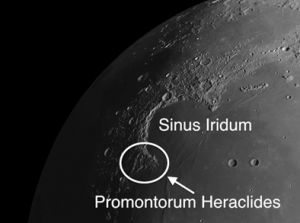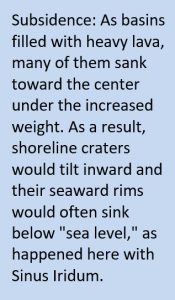The week of September 5-11 takes us from Lunar Day 10 to Day 17. This week we will highlight Sinus Iridum, viewable on Tuesday evening.
 Sinus Iridum: [NW/E6] Sinus Iridum (the Bay of Rainbows), located in the northwest sector of Mare Imbrium, formed after the Imbrium impact but before the lava flooding that filled the Imbrium basin. This bay is itself an enormous 160-mile crater and is the largest and most spectacular example of subsidence on the Moon. If you have very sharp eyes, without optical aid you should be able to see the “bite” that Iridum takes out of Mare Imbrium.
Sinus Iridum: [NW/E6] Sinus Iridum (the Bay of Rainbows), located in the northwest sector of Mare Imbrium, formed after the Imbrium impact but before the lava flooding that filled the Imbrium basin. This bay is itself an enormous 160-mile crater and is the largest and most spectacular example of subsidence on the Moon. If you have very sharp eyes, without optical aid you should be able to see the “bite” that Iridum takes out of Mare Imbrium.
When the Sun is at a low angle (which will be the case Tuesday evening), you can see that Sinus Iridum is covered with wrinkle ridges, resembling many waves lapping toward the shore.
 The Jura Mountains, on the rim of Sinus Iridum, curve protectively around the bay and descend, because of the above-mentioned subsidence, to sea level where they terminate in capes at each end: Promontorium Laplace1 on the northeast, and Promontorium Heraclides on the southwest.
The Jura Mountains, on the rim of Sinus Iridum, curve protectively around the bay and descend, because of the above-mentioned subsidence, to sea level where they terminate in capes at each end: Promontorium Laplace1 on the northeast, and Promontorium Heraclides on the southwest.
Pay close attention to Promontorium Heraclides. Under the right lighting conditions you can see the profile of a woman’s head with long flowing hair as she gazes wistfully out into the bay. Those who have gotten to know her refer to her fondly as the Moon Maiden. Cassini himself was the first person to describe this feature. She reveals herself best when the seeing is a bit “soft” and the terminator has just cleared the western edge of the Jura Mountains. At this time you will see her gazing across the bay to Promontorium Laplace, her hair streaming out behind her. If the seeing is crisp, try defocusing a little.
1 Laplace, Pierre: Promontorium Laplace is named after the French astronomer and mathematician Pierre Laplace (1749-1827) who suggested, long before their discovery, the possibility of black holes. He pointed out that some stars could be so massive that their gravitational pull could prevent even light from escaping their surface. He also proposed, 100 years before their discovery by Edwin Hubble, that there were separate galaxies beyond the Milky Way, and he independently formulated the “Nebula Hypothesis” for the origin of the solar system.
======================
It is highly recommended that you get a copy of Sky and Telescope’s Field Map of the Moon, the very finest Moon map available for use at the telescope. It is available for $10.95 at www.skyandtelescope.com and on Amazon. All features mentioned in this blog will be keyed to the grid on the Field Map and will look like this: Plato: [NW/D9]
Credits:
Courtesy of Gray Photography of Corpus Christi, Texas
Lunar photos: NASA / USGS / BMDO / LROC / ASU / DLR / LOLA / Moon Globe. Used by permission
- Rupes Cauchy: A Best Known Fault on the Moon - July 22, 2024
- Moon Crater Schickard – Crater Floor has Stripes - July 15, 2024
- Moon Craters Langrenus and Vandelinus - July 8, 2024